|
|
|
Sort Order |
|
|
|
Items / Page
|
|
|
|
|
|
|
| Srl | Item |
| 1 |
ID:
169366
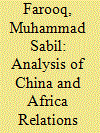

|
|
|
|
|
| Summary/Abstract |
China’s ‘One Belt One Road’ (OBOR) initiative has been billed as its most ambitious project ever in trying to shape and influence behaviour in the international system in line with her growing stature. At the same time, growing Sino-Africa relations have been the subject of scholarly debate with supporters taking an optimistic view, also presented by China itself, of this relationship being a win-win partnership. Critics led by the United States argue China is just using Africa to extract resources for its use, an allegation it refutes. The authors therefore sought to look at Sino-African relations but focussing on the implementation of OBOR in the African continent. Being the centrepiece of China’s foreign policy since 2013, a study on OBOR in Africa will give an understanding and hopefully answer some questions surrounding these relations. The lack of official bilateral agreements between China and some African countries has been examined, together with the possibility of expansion of the OBOR initiative to cover more African states.
|
|
|
|
|
|
|
|
|
|
|
|
|
|
|
|
| 2 |
ID:
158731
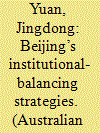

|
|
|
|
|
| Summary/Abstract |
China has in recent years been actively engaged in multilateral diplomacy. From the Shanghai Cooperation Organisation and the Conference on Interaction and Confidence Building Measures in Asia to the Asian Infrastructure Investment Bank and the One Belt, One Road initiative, Beijing is pursuing strategies and promoting norms that are viewed as concerted efforts by China to challenge some of the key institutional arrangements of the existing international order. This article seeks to discuss these contentious issues and assess the rationales, approaches and implications of Chinese diplomacy in initiating and promoting what can be considered as institutional-balancing strategies. The author suggests that the rationales behind these Chinese strategies have as much to do with Beijing’s shifting priorities and the need to address them as with reflecting a degree of dissatisfaction with existing multilateral institutions. And there are more marked differences in Chinese motivations and modalities in security arenas than in economic areas. However, it would be overstating Beijing’s intentions and capabilities if these China-sponsored initiatives are viewed as direct challenges to the existing international and regional orders.
|
|
|
|
|
|
|
|
|
|
|
|
|
|
|
|
| 3 |
ID:
145139
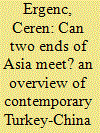

|
|
|
|
|
| Summary/Abstract |
China’s new Silk Road policy, titled “One Belt, One Road,” signals a proactive turn in China’s regional policy towards Central and West Asia. The policy has two dimensions: First, China aims to revitalize the old Silk Road exchange of goods, ideas, and people with trade, energy, and transportation projects. Second, armed with these new connections, China aims to redefine the territories the old Silk Road encompasses as a region in the contemporary international system. Turkey, as one of the countries at the westernmost end of the historic Silk Road, and one of the target countries of China’s new Silk Road diplomacy, welcomes the increasing economic and technological exchange with China. Establishing better contacts with China fits suitably in Turkey’s new foreign policy orientation. While the foreign policies of the two countries seem to be compatible, Turkish domestic political dynamics and public opinion hinder further engagement between the two ends of the Silk Road. The negative public opinion towards China manifests itself in the form of media coverage, protests and lobbying and, at times, it derails bilateral relations. This paper assesses the prospects for bilateral relations in the light of these developments. The paper starts with a historical analysis of Sino-Turkish relations and proceeds with various dimensions of the current relations. Then, it provides an analysis of various public opinion surveys in order to grasp the nature of the Turkish public opinion towards China, and it offers a media framing analysis in order to decipher the specific ways the image of China is constructed in Turkish public opinion. The last part of the paper discusses the domestic political actors that have a role in the perceptions and policies toward China in Turkey.
|
|
|
|
|
|
|
|
|
|
|
|
|
|
|
|
| 4 |
ID:
163994
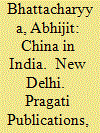

|
|
|
|
|
| Publication |
New Delhi, Pragati Publications, 2018.
|
| Description |
xxiii, 363p.: ill.hbk
|
| Standard Number |
9788173071720
|
|
|
|
|
|
|
|
|
|
|
|
Copies: C:1/I:0,R:0,Q:0
Circulation
| Accession# | Call# | Current Location | Status | Policy | Location |
| 059593 | 327.51054/BHA 059593 | Main | On Shelf | General | |
|
|
|
|
| 5 |
ID:
154032
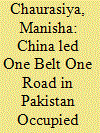

|
|
|
|
|
| Summary/Abstract |
The strategic scenario for India in the region is altering like never before with the One Belt One Road (OBOR) project running through Pakistan occupied Kashmir (PoK) in form of China Pakistan Economic Corridor (CPEC). Without India even geographically moving an inch in the Kashmir region, the circumstances of geo-politics around it have seriously modified in the negative. These developments for a number of reasons are alarming as they are against the Indian strategic and core interests.
|
|
|
|
|
|
|
|
|
|
|
|
|
|
|
|
| 6 |
ID:
163064
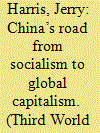

|
|
|
|
|
| Summary/Abstract |
China’s engagement with global capitalism is driven by the emergence of a statist and private transnational capitalist class. Nevertheless, aspects of China’s foreign policy from the Maoist period still echo today. Consequently, elements of third world solidarity and opposition to Western domination continue to exist as China’s past is redefined to further its transnational strategies in Latin America and the US. The main Chinese investments in South America have been in energy and infrastructure among the left lead countries of the Pink Tide. In the US, Chinese capital has grown despite heated political rhetoric. This paper will examine how economic ties in South and North America reflect past and present conditions, and if China has initiated a non-Western globalisation.
|
|
|
|
|
|
|
|
|
|
|
|
|
|
|
|
| 7 |
ID:
146378
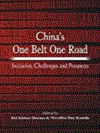

|
|
|
|
|
| Publication |
New Delhi, Vij Books India Pvt. Ltd, 2016.
|
| Description |
xiv, 117p.hbk
|
| Standard Number |
9789385563591
|
|
|
|
|
|
|
|
|
|
|
|
Copies: C:1/I:0,R:0,Q:0
Circulation
| Accession# | Call# | Current Location | Status | Policy | Location |
| 058756 | 327.51/SHA 058756 | Main | On Shelf | General | |
|
|
|
|
| 8 |
ID:
143685
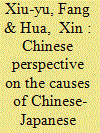

|
|
|
|
|
| Summary/Abstract |
Chinese-Japanese relations have become increasingly tense in recent years. It might
be concluded superficially that the recent tensions originated from the historical
issues and the bilateral sovereignty disputes over some islands. However, these
tensions are deeply rooted in the structural contradictions of these bilateral relations,
such as the conflicting national strategies of China and Japan, the relative balance
of power between them, and the discrepancy of their interests in their games
against the background of macro transition of the overall strategic pattern of the
Asia-Pacific region. Furthermore, the U.S. strategic dilemma in this gaming process
adds destabilizing factors to the development of China-Japan bilateral relations.
The outcomes of the China-Japan tensions not only affect the rise and fall of the
relative strengths of these two countries, but also have major influences over the
general strategic arrangements of East Asia and the whole Asia-Pacific. Therefore,
it is very meaningful to probe the deep-rooted causes of the Chinese-Japanese
conflicts and to observe current China-Japan relations from the strategic perspective
because some solutions might be discoverd in this way.
|
|
|
|
|
|
|
|
|
|
|
|
|
|
|
|
| 9 |
ID:
172610
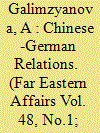

|
|
|
|
|
| Summary/Abstract |
The current state of bilateral Chinese-German relations is considered. It is shown that cooperation between the two countries is marked by both successes and difficulties. Analysis of their state leads the author to conclude that relations between China and Germany are generally of a constructive and friendly nature, and are consistently aimed at strengthening the two countries' strategic dialog.
|
|
|
|
|
|
|
|
|
|
|
|
|
|
|
|
| 10 |
ID:
168510
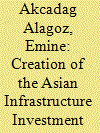

|
|
|
|
|
| Summary/Abstract |
The aim of this article is to assess the creation of the China-led Asian Infrastructure Investment Bank within the scope of China’s smart power strategy, which will help not only to analyze China’s strategic use of its coercive and co-optive capacity, but also to understand better the concept of smart power. Given that the wisdom of statecraft can only be situationally determined, through this study I will propose the ability to achieve targeted objectives, the skill to use hard and soft power instruments in such a way that they reinforce each other, good interpretation of the existing regional and global contexts, time planning, and compatibility with long-term interests as criteria for judging the effectiveness of a smart power implementation.
|
|
|
|
|
|
|
|
|
|
|
|
|
|
|
|
| 11 |
ID:
161776
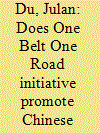

|
|
|
|
|
| Summary/Abstract |
In response to the One Belt One Road (OBOR) initiative, China's overseas direct investment (ODI), especially whole or majority-ownership mergers and acquisitions, rose significantly in the belt-road countries, especially the ones along the continental route. Comparatively speaking, China's state-controlled acquirers played a leading role in infrastructure sectors, whereas the non-state-controlled acquirers were particularly active in non-infrastructure sectors. Central and West Asia, Western Europe and Russia are favorable destinations of Chinese ODI.
|
|
|
|
|
|
|
|
|
|
|
|
|
|
|
|
| 12 |
ID:
154373


|
|
|
|
|
| Summary/Abstract |
The Corridor is, first and foremost, a vital investment for Beijing, which is slowly buying the strategic link, Beijing will soon control its new dominion, Pakistan. For India, it will be game changer as it will then directly face China on two fronts, the Northern and the Western. The Modi government should ponder about this.It is a new great but not easy game. What looks like a masterstroke on paper could turn into a nightmare for both China and Pakistan, unless India is taken onboard.But at a time Pakistan continues to fuel unrest in the Kashmir valley with the silent consent of China, how can Islamabad get New Delhi's blessings for such a gigantic project? Today, China and Pakistan may be gambling, but China has no choice but to understand India's concerns on this issue.
|
|
|
|
|
|
|
|
|
|
|
|
|
|
|
|
| 13 |
ID:
163155
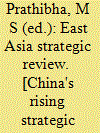

|
|
|
|
|
| Publication |
New Delhi, Pentagon Press, 2018.
|
| Description |
xiv, 262p.hbk
|
| Standard Number |
9789386618658
|
|
|
|
|
|
|
|
|
|
|
|
Copies: C:2/I:0,R:0,Q:0
Circulation
| Accession# | Call# | Current Location | Status | Policy | Location |
| 059576 | 327.51/PRA 059576 | Main | On Shelf | General | |
| 059577 | 327.51/PRA 059577 | Main | On Shelf | General | |
|
|
|
|
| 14 |
ID:
164086
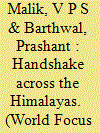

|
|
|
|
|
| Summary/Abstract |
With the embracing relations amongst China and Nepal in the Himalayas there is more stir, like foreign policies of global world, in the academic circle. In the uphill of the Himalayas, the outbreak of infrastructure reflects the emerging consolidation of two most ambitious plans in South Asian territory- One, Nepal’s infrastructural development through enhancement over technology, and two, China’s dream project, i.e. ‘Belt Road Initiative’ (BRI). The outcome of the massive earthquake in Nepalese boundaries ends in heavy infrastructural assistance, re-opening border points and re-routing of trans- Himalayas trade route between both the countries.
|
|
|
|
|
|
|
|
|
|
|
|
|
|
|
|
| 15 |
ID:
191960
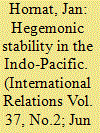

|
|
|
|
|
| Summary/Abstract |
The United States has improved relations with no other country during the Trump administration as much as it advanced its relationship with India. US-India relations have arguably marked their historical high points since Trump entered office and India seems to be overcoming its suspicion of closer cooperation with the US. Given these developments, this article aims to theorize the relationship through the hegemonic stability theory and explain US strategy toward India. We first demonstrate why India is accepting the hegemonic standing of the US in the Indo-Pacific and then – since balance of power politics are still a staple of policymakers’ approach to stability in the Indo-Pacific – we introduce the notion of induced balancing to show what approach the United States has adopted to empower India to expand its balancing capacity vis-à-vis China. The last section of the article empirically maps the various incentives that Washington offers to New Delhi in order to situate it in the desired position of a proxy China-balancer.
|
|
|
|
|
|
|
|
|
|
|
|
|
|
|
|
| 16 |
ID:
164060
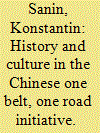

|
|
|
|
|
| Summary/Abstract |
The One Belt, One Road initiative has become a very important contribution of the fifth generation of PRC leaders to the development of China's foreign policy, which has determined the vector of the country's relations with its neighbor countries for the foreseeable future. The Chinese authorities regard this initiative as a principally new phenomenon in world politics, pointing to its direct connection with the historical practice of cooperation in the vast area of the Silk Road and a traditional Chinese approach to relations with its neighbors.
|
|
|
|
|
|
|
|
|
|
|
|
|
|
|
|
| 17 |
ID:
141576


|
|
|
|
|
| Summary/Abstract |
On 14 March 2013 President Xi Jinping took over as the president of People’s Republic of China, and also became a ‘paramount leader’, wearing all three hats simultaneously: the all-powerful general secretary of the Communist Party of China and Chairman, Central Military Commission, in addition to being the President.
|
|
|
|
|
|
|
|
|
|
|
|
|
|
|
|
| 18 |
ID:
160483
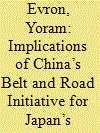

|
|
|
|
|
| Summary/Abstract |
In recent years, the ties between Asian powers and Middle Eastern countries have grown significantly, and the consequence of this development is a gradual spin-off of intra-Asian political process to the Middle East. China’s Belt and Road Initiative (BRI) provides an intriguing illustration of such a possible spin-off. Japan’s response to BRI is mostly negative but less clear is the possible implications of the China–Japan confrontation over BRI for their interaction with the Middle East. Japan’s responses to the BRI and China’s perceptions thereof can expand the set of factors that shape the two Asian powers’ involvement in that region.
|
|
|
|
|
|
|
|
|
|
|
|
|
|
|
|
| 19 |
ID:
147995
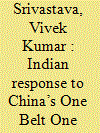

|
|
|
|
|
| Summary/Abstract |
Indian response to China’s One Belt One Road is well structured and is largely governed by the soft power approach. Chinese policy is solely dependent upon the economic interests whereas the India policy starts with soft power diplomacy but is also aimed to reach to develop the close economic-political relationships with the targeted countries. Indian response is more practical and is based on the understanding the needs of the concerned countries. The start has been made with simple efforts as the maritime cooperation, interaction at the trade discussion level.
|
|
|
|
|
|
|
|
|
|
|
|
|
|
|
|
| 20 |
ID:
160646
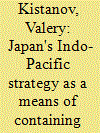

|
|
|
|
|
| Summary/Abstract |
This article analyzes Japan's policy in the basin of the Pacific and Indian Oceans. The term "Indo-Pacific Region" is more often used in scientific circles and mass media now instead of Asia-Pacific Region, which reflects the radical economic and political shifts in the basin of the two oceans. The Indo-Pacific strategy of Premier of Japan Shinzo Abe has an aim to contain the growing economic and military might of China - the main geopolitical rival of Japan in Asia. However, the implementation of this strategy faces difficulties.
|
|
|
|
|
|
|
|
|
|
|
|
|
|
|
|
|
|
|
|
|